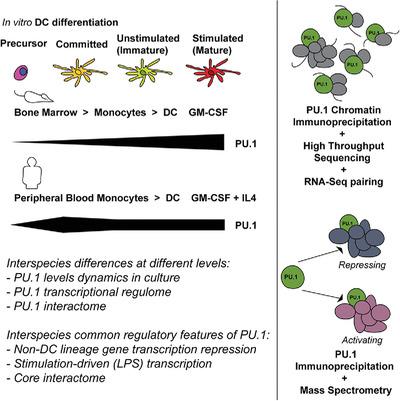当前位置:
X-MOL 学术
›
J. Leukoc. Biol.
›
论文详情
Our official English website, www.x-mol.net, welcomes your
feedback! (Note: you will need to create a separate account there.)
Comparison of the PU.1 transcriptional regulome and interactome in human and mouse inflammatory dendritic cells
Journal of Leukocyte Biology ( IF 3.6 ) Pub Date : 2020-12-02 , DOI: 10.1002/jlb.6a1219-711rrr Maaike R Scheenstra 1, 2 , Patricia Martínez-Botía 3 , Andrea Acebes-Huerta 3 , Rutger W W Brouwer 4, 5 , Noemí Caballero-Sánchez 3 , Nynke Gillemans 5 , Pieter De Bleser 6, 7 , Benjamin Nota 1 , Iris M De Cuyper 1 , Vishal Salunkhe 1 , Andrea M Woltman 8, 9 , Lianne van de Laar 8 , Erikjan Rijkers 10 , Jeroen A A Demmers 10 , Wilfred F J van IJcken 4, 5 , Sjaak Philipsen 5 , Timo K van den Berg 1 , Taco W Kuijpers 1, 11, 12 , Laura Gutiérrez 1, 3, 13
Journal of Leukocyte Biology ( IF 3.6 ) Pub Date : 2020-12-02 , DOI: 10.1002/jlb.6a1219-711rrr Maaike R Scheenstra 1, 2 , Patricia Martínez-Botía 3 , Andrea Acebes-Huerta 3 , Rutger W W Brouwer 4, 5 , Noemí Caballero-Sánchez 3 , Nynke Gillemans 5 , Pieter De Bleser 6, 7 , Benjamin Nota 1 , Iris M De Cuyper 1 , Vishal Salunkhe 1 , Andrea M Woltman 8, 9 , Lianne van de Laar 8 , Erikjan Rijkers 10 , Jeroen A A Demmers 10 , Wilfred F J van IJcken 4, 5 , Sjaak Philipsen 5 , Timo K van den Berg 1 , Taco W Kuijpers 1, 11, 12 , Laura Gutiérrez 1, 3, 13
Affiliation

|
Dendritic cells (DCs) are key immune modulators and are able to mount immune responses or tolerance. DC differentiation and activation imply a plethora of molecular and cellular responses, including transcriptional changes. PU.1 is a highly expressed transcription factor in DCs and coordinates relevant aspects of DC biology. Due to their role as immune regulators, DCs pose as a promising immunotherapy tool. However, some of their functional features, such as survival, activation, or migration, are compromised due to the limitations to simulate in vitro the physiologic DC differentiation process. A better knowledge of transcriptional programs would allow the identification of potential targets for manipulation with the aim of obtaining “qualified” DCs for immunotherapy purposes. Most of the current knowledge regarding DC biology derives from studies using mouse models, which not always find a parallel in human. In the present study, we dissect the PU.1 transcriptional regulome and interactome in mouse and human DCs, in the steady state or LPS activated. The PU.1 transcriptional regulome was identified by performing PU.1 chromatin immunoprecipitation followed by high-throughput sequencing and pairing these data with RNAsequencing data. The PU.1 interactome was identified by performing PU.1 immunoprecipitation followed by mass spectrometry analysis. Our results portray PU.1 as a pivotal factor that plays an important role in the regulation of genes required for proper DC activation and function, and assures the repression of nonlineage genes. The interspecies differences between human and mouse DCs are surprisingly substantial, highlighting the need to study the biology of human DCs.
中文翻译:

人和小鼠炎症树突状细胞中 PU.1 转录调节组和相互作用组的比较
树突状细胞 (DC) 是关键的免疫调节剂,能够引发免疫反应或耐受。 DC 的分化和激活意味着大量的分子和细胞反应,包括转录变化。 PU.1 是 DC 中高表达的转录因子,协调 DC 生物学的相关方面。由于其作为免疫调节剂的作用,树突状细胞成为一种有前途的免疫治疗工具。然而,由于体外模拟 DC 生理分化过程的局限性,它们的一些功能特征(例如存活、激活或迁移)受到损害。对转录程序的更好了解将有助于识别潜在的操作目标,从而获得用于免疫治疗目的的“合格”DC。目前关于 DC 生物学的大部分知识都源自使用小鼠模型的研究,但在人类中并不总能找到类似的情况。在本研究中,我们剖析了处于稳定状态或 LPS 激活状态的小鼠和人类 DC 中的 PU.1 转录调节组和相互作用组。通过执行 PU.1 染色质免疫沉淀、随后进行高通量测序并将这些数据与 RNA 测序数据配对来鉴定 PU.1 转录调控组。通过进行 PU.1 免疫沉淀和质谱分析来鉴定 PU.1 相互作用组。我们的结果将 PU.1 描述为一个关键因子,在 DC 适当激活和功能所需的基因调节中发挥重要作用,并确保非谱系基因的抑制。人类和小鼠 DC 之间的种间差异令人惊讶地巨大,这凸显了研究人类 DC 生物学的必要性。
更新日期:2020-12-02
中文翻译:

人和小鼠炎症树突状细胞中 PU.1 转录调节组和相互作用组的比较
树突状细胞 (DC) 是关键的免疫调节剂,能够引发免疫反应或耐受。 DC 的分化和激活意味着大量的分子和细胞反应,包括转录变化。 PU.1 是 DC 中高表达的转录因子,协调 DC 生物学的相关方面。由于其作为免疫调节剂的作用,树突状细胞成为一种有前途的免疫治疗工具。然而,由于体外模拟 DC 生理分化过程的局限性,它们的一些功能特征(例如存活、激活或迁移)受到损害。对转录程序的更好了解将有助于识别潜在的操作目标,从而获得用于免疫治疗目的的“合格”DC。目前关于 DC 生物学的大部分知识都源自使用小鼠模型的研究,但在人类中并不总能找到类似的情况。在本研究中,我们剖析了处于稳定状态或 LPS 激活状态的小鼠和人类 DC 中的 PU.1 转录调节组和相互作用组。通过执行 PU.1 染色质免疫沉淀、随后进行高通量测序并将这些数据与 RNA 测序数据配对来鉴定 PU.1 转录调控组。通过进行 PU.1 免疫沉淀和质谱分析来鉴定 PU.1 相互作用组。我们的结果将 PU.1 描述为一个关键因子,在 DC 适当激活和功能所需的基因调节中发挥重要作用,并确保非谱系基因的抑制。人类和小鼠 DC 之间的种间差异令人惊讶地巨大,这凸显了研究人类 DC 生物学的必要性。











































 京公网安备 11010802027423号
京公网安备 11010802027423号